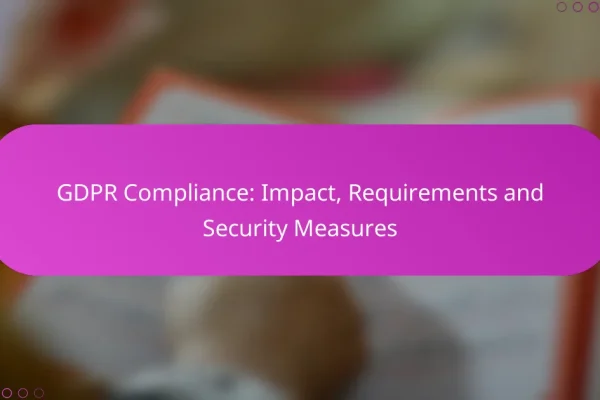What are the best security measures for web application performance?
The best security measures for web application performance focus on protecting data while ensuring fast and reliable access. Implementing a combination of technologies and practices can significantly enhance both security and performance.
Web Application Firewalls (WAF)
A Web Application Firewall (WAF) acts as a shield between web applications and potential threats, filtering and monitoring HTTP traffic. It helps to block malicious requests, such as SQL injection or cross-site scripting, which can compromise application integrity.
When choosing a WAF, consider whether to use a cloud-based or on-premises solution. Cloud-based WAFs often provide easier scalability and maintenance, while on-premises options may offer more control over data handling.
Content Delivery Networks (CDN)
A Content Delivery Network (CDN) improves web application performance by distributing content across multiple servers worldwide. This reduces latency and speeds up load times, as users access data from the nearest server location.
Integrating a CDN can also enhance security by providing DDoS protection and shielding the origin server from direct traffic. Look for CDNs that offer robust security features alongside performance enhancements.
Regular Security Audits
Conducting regular security audits is essential for identifying vulnerabilities in web applications. These audits can include code reviews, penetration testing, and compliance checks against industry standards.
Establish a routine schedule for audits, such as quarterly or bi-annually, and ensure that findings are addressed promptly. This proactive approach helps maintain security and performance over time.
Data Encryption Techniques
Data encryption techniques protect sensitive information both in transit and at rest. Using protocols like TLS for data in transit and AES for stored data ensures that unauthorized access is minimized.
Implementing encryption can add some overhead, but the trade-off is worth it for safeguarding user data. Always keep encryption keys secure and regularly update encryption methods to stay ahead of potential threats.
Access Control Policies
Access control policies define who can access specific resources within a web application. Implementing role-based access control (RBAC) ensures that users only have access to the information necessary for their roles.
Regularly review and update access controls to reflect changes in personnel or organizational structure. This practice helps prevent unauthorized access and enhances overall security without sacrificing performance.
How do Web Application Firewalls improve performance?
Web Application Firewalls (WAFs) enhance performance by filtering and monitoring HTTP traffic between a web application and the internet. They help mitigate attacks while optimizing resource usage, leading to faster response times and improved user experience.
Blocking malicious traffic
WAFs effectively block malicious traffic by analyzing incoming requests and identifying patterns associated with threats such as SQL injection and cross-site scripting. By filtering out harmful requests before they reach the server, WAFs protect applications from potential breaches and downtime.
Implementing a WAF can significantly reduce the risk of data breaches, which can be costly in terms of both finances and reputation. Regularly updating the WAF’s rules and signatures is crucial to maintain its effectiveness against evolving threats.
Reducing server load
By intercepting and blocking malicious traffic, WAFs help reduce the load on web servers, allowing them to focus on legitimate requests. This can lead to improved performance, especially during high-traffic periods when server resources are strained.
Additionally, WAFs can cache responses for frequently requested content, further decreasing server load and enhancing response times. It’s advisable to monitor the WAF’s performance metrics to ensure optimal configuration and resource allocation.
What role do Content Delivery Networks play in security?
Content Delivery Networks (CDNs) enhance web application security by distributing content across multiple servers, which helps to reduce the risk of attacks and improve load times. They act as a barrier between users and the origin server, providing additional layers of protection against various threats.
Distributing traffic
CDNs distribute traffic across a network of servers located in various geographical locations. This distribution helps to balance the load, ensuring that no single server is overwhelmed by requests. By spreading out the traffic, CDNs can improve response times and reduce latency, which is crucial for maintaining a seamless user experience.
For example, if a web application experiences a sudden spike in traffic, a CDN can automatically reroute requests to the nearest server. This not only enhances performance but also minimizes the risk of server overload, which can lead to downtime or degraded service.
Mitigating DDoS attacks
CDNs play a significant role in mitigating Distributed Denial of Service (DDoS) attacks by absorbing and dispersing malicious traffic before it reaches the origin server. By filtering out harmful requests, CDNs can maintain service availability even during an attack.
Many CDNs offer built-in DDoS protection features that automatically detect and respond to unusual traffic patterns. This proactive approach can significantly reduce the impact of such attacks, allowing legitimate users to access the web application without interruption. Businesses should consider CDNs with strong DDoS mitigation capabilities as part of their overall security strategy.
What are the key components of a security audit?
A security audit involves several critical components that ensure the integrity and safety of web applications. Key elements include vulnerability scanning, code review processes, and compliance checks, all aimed at identifying and mitigating potential security risks.
Vulnerability scanning
Vulnerability scanning is a systematic process that identifies security weaknesses in a web application. This can be achieved using automated tools that scan for known vulnerabilities, misconfigurations, and outdated software components.
It is essential to conduct these scans regularly, ideally on a monthly basis, to stay updated on emerging threats. Common tools include Nessus, Qualys, and OpenVAS, which can provide detailed reports on identified vulnerabilities.
Code review processes
Code review processes involve examining the source code of a web application to identify security flaws and ensure adherence to best practices. This can be done through manual reviews or automated tools that analyze code for vulnerabilities.
Implementing peer reviews and using static application security testing (SAST) tools can significantly enhance code quality. Aim for regular reviews, especially before major releases, to catch issues early and reduce the risk of exploitation.
How can data encryption enhance web application security?
Data encryption significantly enhances web application security by converting sensitive information into a coded format that is unreadable without the appropriate decryption key. This process protects data during transmission and storage, making it difficult for unauthorized users to access or manipulate the information.
Protecting sensitive information
Data encryption safeguards sensitive information such as personal identification details, payment information, and confidential communications. By using strong encryption algorithms, like AES or RSA, organizations can ensure that even if data is intercepted, it remains secure and inaccessible to attackers.
Implementing encryption protocols such as HTTPS for web traffic is essential. This not only encrypts data in transit but also helps build trust with users, as they can see that their information is being handled securely.
Ensuring data integrity
Data integrity refers to the accuracy and consistency of data over its lifecycle. Encryption helps maintain data integrity by preventing unauthorized alterations during transmission or storage. When data is encrypted, any unauthorized changes would render the data unreadable, alerting the system to potential tampering.
To further enhance data integrity, organizations can use hashing algorithms alongside encryption. Hashing creates a unique digital fingerprint of the data, allowing for easy verification of its authenticity. Regularly checking these hashes can help identify any unauthorized modifications quickly.
What access control policies should be implemented?
Access control policies are essential for securing web applications by defining who can access specific resources and what actions they can perform. Implementing robust access control measures helps prevent unauthorized access and protects sensitive data.
Role-Based Access Control (RBAC)
Role-Based Access Control (RBAC) assigns permissions based on user roles within an organization. Each role has specific access rights, which simplifies management and enhances security by limiting access to only what is necessary for each role. For instance, an employee in finance may have access to financial records, while a marketing employee does not.
When implementing RBAC, it’s crucial to regularly review roles and permissions to ensure they align with current organizational needs. This helps prevent privilege creep, where users accumulate access rights over time that they no longer require.
Attribute-Based Access Control (ABAC)
Attribute-Based Access Control (ABAC) evaluates user attributes, resource attributes, and environmental conditions to make access decisions. This dynamic approach allows for more granular control compared to RBAC, as it can consider various factors like user location, time of access, and device type.
For example, an employee may have access to certain data only during business hours and only when connected to a secure network. Implementing ABAC requires a robust policy framework to define the attributes and rules governing access, which can be complex but offers enhanced flexibility.
Mandatory Access Control (MAC)
Mandatory Access Control (MAC) is a stricter access control model where access rights are regulated by a central authority based on security classifications. Users cannot change access permissions, which is ideal for environments requiring high security, such as government or military applications.
In MAC, resources are classified into different levels (e.g., confidential, secret, top secret), and users are granted access based on their clearance level. While this model provides strong security, it can be inflexible and may hinder collaboration if not managed properly.
Discretionary Access Control (DAC)
Discretionary Access Control (DAC) allows users to control access to their own resources. Users can grant or revoke permissions to others at their discretion, making it a more flexible but potentially less secure option. This model is common in personal file-sharing applications.
While DAC promotes ease of use and collaboration, it can lead to security risks if users are not careful about whom they share access with. Organizations using DAC should implement guidelines and training to help users manage permissions responsibly.












